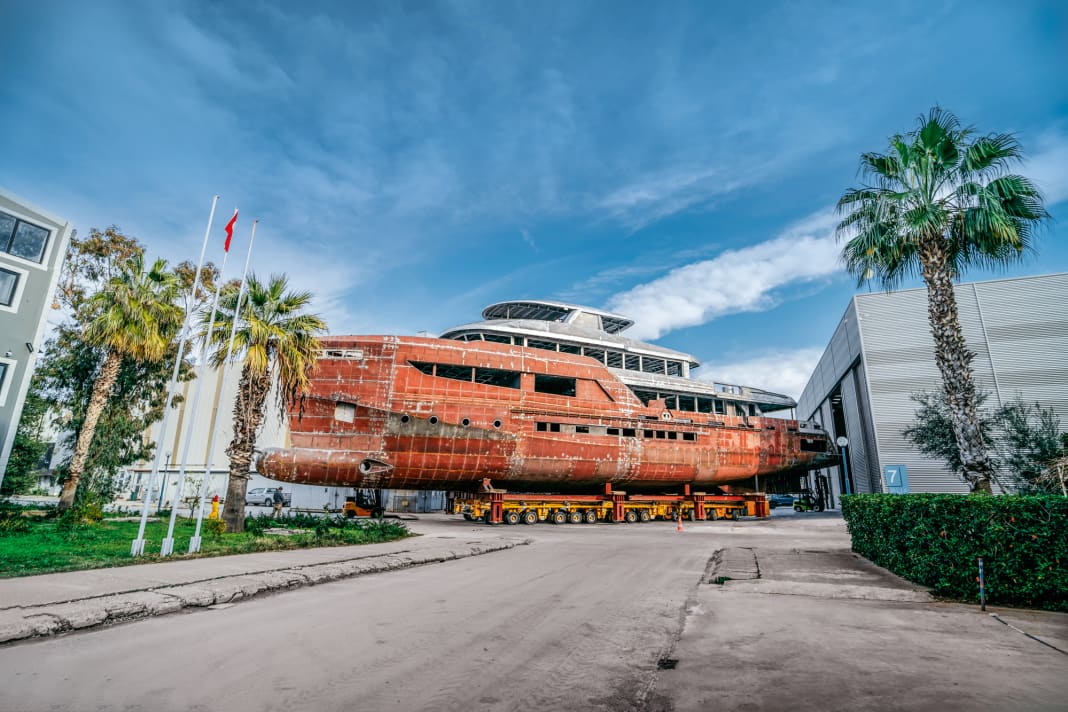





Full capacity utilisation is a phrase that many a shipyard uses to make a promising claim. These broad calculations then include projects that are still in the design or construction phase or are even based on expressions of interest. Not so with Bering Yachts. The shipyard based in Raleigh, North Carolina, is working on eleven orders in Antalya: four Bering 80s and one each 145, 125, 117, 78, 75, 72 and 65.
A hall extension in the form of an enclosure makes it clear that all the building sites are actually occupied. It contains the stern of the Bering 75, which stands behind a Bering 80. Elsewhere, even a steel aft section still peeps out of the hall uncovered. It belongs to one of two Bering 80 hulls recently towed in from Istanbul; four units of the 220-tonner have already been sold and are under construction. One is in Istanbul, another came from there and now occupies an open space behind the quays of the free trade zone. The legs are simply welded onto the steel hull in the form of pipes and the 80-foot model is placed on stilts like a polar station.
Rapid growth, unshakeable Explorer values
The Bering halls are spread across the entire free trade zone, a sign of the rapid, unforeseen growth. There has been a real Covid boom, reports Bogdan Gusarev, who represents Bering Yachts in Europe. Owners are looking for yachts that can go anywhere - and stay there for a longer period of time and withstand the most severe storms. "The majority of our customers are between their mid-30s and 60s and have previously had experience with GRP yachts, but wanted more comfort," says Gusarev in the largest hall, where work is being carried out on five hulls and the offices of Bering Naval's designers are adjacent.
Nothing works at Bering Yachts without highly compacted metal, once even the superstructures were made of it. Even the hull of the smallest model, the almost 20 metre long Bering 65, is made of steel. This is Bering's unique selling point and niche. Ten-millimetre-thick hull plates and six-millimetre-thick aluminium plates are used. In addition to safety, travelling comfort is the top priority. Gusarev invites us to the stern of a Bering 80 and points to the skeg: "We took this from fishing trawlers. The shaft rotates in an oil bath and runs horizontally to low-lying engines." The skeg protects the rudder blades and is designed to prevent cavitation. In general, the efficiency is higher due to better airflow, and vibrations and noise emissions are reduced. Everything on Bering yachts is designed to cope with long passages at night while guests sleep peacefully and enjoy the day in a new bay.
Bering explorer with low centre of mass
The partially high-built Explorers are also equipped for rough seas. The low centre of gravity one metre above the surface of the water alone means that they should roll very little. The construction follows the motto: weight is our friend. Even in the smaller models, the displacement is equal to the volume. In addition, fin stabilisers are installed, two pairs from 24 metres upwards. Indispensable - even at 20 metres - are watertight bulkheads, double emergency exits, fast-mount panels and vibration dampers in the interior, two anchor systems and access to the engine compartment from the outside and inside to prevent flooding in high seas.
Alexei Mikhailov greets you in his office, with sketches of the new Bering 120 hanging on the walls, wearing a grey Bering shirt. It is part of the new textile collection that he is trying out on himself and is not yet happy with. Mikhailov perfectly epitomises the "hands-on approach", as it is so aptly called in English. He comes from Magadan on the coast of the Sea of Okhotsk in north-east Siberia. After studying hydrogeology, he moved into the private sector in 1990. In the year of the great upheaval, he and a partner bought a 42 metre long steel ship for crew transfers at the age of 26. After converting it and using it for two years as an excursion boat, they sold it to China.
A shipyard founder who sought the best in steel for himself
Mikhailov then sought his business fortune in the USA, where he bought his first runabout in 1996. "The next GRP boat burnt out completely within twelve minutes after a cable fire. We were close to the coast and nothing happened to my wife and I," he reports. "Between 2000 and 2005, I had my own fishing fleet in the far north and learnt what powers lie dormant in the sea."
Mikhailov knew exactly what he wanted and turned his hobby into a business. Bering Yachts started in 2007 in the USA and with an outsourced shipyard in China. Ten years ago, he set up production in Turkey with just under 20 employees; now up to 60 per cent of the work is carried out by his own staff, and a new site in Bulgaria is about to be opened.
What does the future hold once the record order book has been processed? "In charter," says the shipyard founder. "Our yachts under 24 metres are commercially classified, equipped like superyachts and offer the same level of comfort, but are significantly cheaper." The company plans to build its own fleet and also offer berth charters. "Voyages to exotic or remote locations are conceivable. Our yachts can reach all areas that are accessible by sea." The latter corresponds to Bering's simple and apt definition of an explorer. Everywhere. Always.

